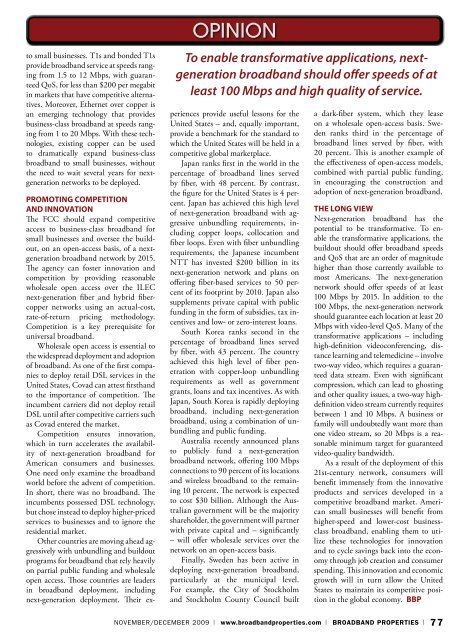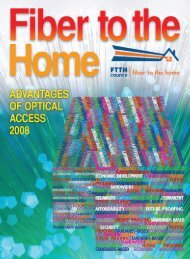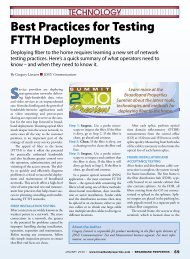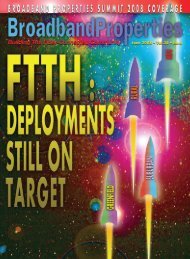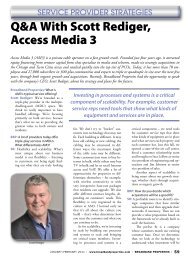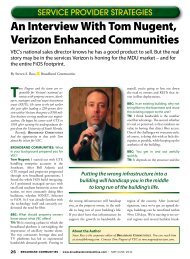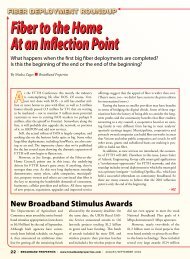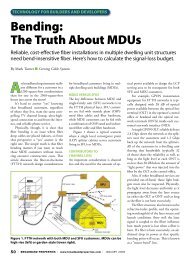2010 Buyers Guide - Broadband Properties
2010 Buyers Guide - Broadband Properties
2010 Buyers Guide - Broadband Properties
You also want an ePaper? Increase the reach of your titles
YUMPU automatically turns print PDFs into web optimized ePapers that Google loves.
to small businesses. T1s and bonded T1s<br />
provide broadband service at speeds ranging<br />
from 1.5 to 12 Mbps, with guaranteed<br />
QoS, for less than $200 per megabit<br />
in markets that have competitive alternatives.<br />
Moreover, Ethernet over copper is<br />
an emerging technology that provides<br />
business-class broadband at speeds ranging<br />
from 1 to 20 Mbps. With these technologies,<br />
existing copper can be used<br />
to dramatically expand business-class<br />
broadband to small businesses, without<br />
the need to wait several years for nextgeneration<br />
networks to be deployed.<br />
OPINION<br />
To enable transformative applications, nextgeneration<br />
broadband should offer speeds of at<br />
least 100 Mbps and high quality of service.<br />
Promoting Competition<br />
and Innovation<br />
The FCC should expand competitive<br />
access to business-class broadband for<br />
small businesses and oversee the buildout,<br />
on an open-access basis, of a nextgeneration<br />
broadband network by 2015.<br />
The agency can foster innovation and<br />
competition by providing reasonable<br />
wholesale open access over the ILEC<br />
next-generation fiber and hybrid fibercopper<br />
networks using an actual-cost,<br />
rate-of-return pricing methodology.<br />
Competition is a key prerequisite for<br />
universal broadband.<br />
Wholesale open access is essential to<br />
the widespread deployment and adoption<br />
of broadband. As one of the first companies<br />
to deploy retail DSL services in the<br />
United States, Covad can attest firsthand<br />
to the importance of competition. The<br />
incumbent carriers did not deploy retail<br />
DSL until after competitive carriers such<br />
as Covad entered the market.<br />
Competition ensures innovation,<br />
which in turn accelerates the availability<br />
of next-generation broadband for<br />
American consumers and businesses.<br />
One need only examine the broadband<br />
world before the advent of competition.<br />
In short, there was no broadband. The<br />
incumbents possessed DSL technology,<br />
but chose instead to deploy higher-priced<br />
services to businesses and to ignore the<br />
residential market.<br />
Other countries are moving ahead aggressively<br />
with unbundling and buildout<br />
programs for broadband that rely heavily<br />
on partial public funding and wholesale<br />
open access. Those countries are leaders<br />
in broadband deployment, including<br />
next-generation deployment. Their experiences<br />
provide useful lessons for the<br />
United States – and, equally important,<br />
provide a benchmark for the standard to<br />
which the United States will be held in a<br />
competitive global marketplace.<br />
Japan ranks first in the world in the<br />
percentage of broadband lines served<br />
by fiber, with 48 percent. By contrast,<br />
the figure for the United States is 4 percent.<br />
Japan has achieved this high level<br />
of next-generation broadband with aggressive<br />
unbundling requirements, including<br />
copper loops, collocation and<br />
fiber loops. Even with fiber unbundling<br />
requirements, the Japanese incumbent<br />
NTT has invested $200 billion in its<br />
next-generation network and plans on<br />
offering fiber-based services to 50 percent<br />
of its footprint by <strong>2010</strong>. Japan also<br />
supplements private capital with public<br />
funding in the form of subsidies, tax incentives<br />
and low- or zero-interest loans.<br />
South Korea ranks second in the<br />
percentage of broadband lines served<br />
by fiber, with 43 percent. The country<br />
achieved this high level of fiber penetration<br />
with copper-loop unbundling<br />
requirements as well as government<br />
grants, loans and tax incentives. As with<br />
Japan, South Korea is rapidly deploying<br />
broadband, including next-generation<br />
broadband, using a combination of unbundling<br />
and public funding.<br />
Australia recently announced plans<br />
to publicly fund a next-generation<br />
broadband network, offering 100 Mbps<br />
connections to 90 percent of its locations<br />
and wireless broadband to the remaining<br />
10 percent. The network is expected<br />
to cost $30 billion. Although the Australian<br />
government will be the majority<br />
shareholder, the government will partner<br />
with private capital and – significantly<br />
– will offer wholesale services over the<br />
network on an open-access basis.<br />
Finally, Sweden has been active in<br />
deploying next-generation broadband,<br />
particularly at the municipal level.<br />
For example, the City of Stockholm<br />
and Stockholm County Council built<br />
a dark-fiber system, which they lease<br />
on a wholesale open-access basis. Sweden<br />
ranks third in the percentage of<br />
broadband lines served by fiber, with<br />
20 percent. This is another example of<br />
the effectiveness of open-access models,<br />
combined with partial public funding,<br />
in encouraging the construction and<br />
adoption of next-generation broadband.<br />
The Long View<br />
Next-generation broadband has the<br />
potential to be transformative. To enable<br />
the transformative applications, the<br />
buildout should offer broadband speeds<br />
and QoS that are an order of magnitude<br />
higher than those currently available to<br />
most Americans. The next-generation<br />
network should offer speeds of at least<br />
100 Mbps by 2015. In addition to the<br />
100 Mbps, the next-generation network<br />
should guarantee each location at least 20<br />
Mbps with video-level QoS. Many of the<br />
transformative applications – including<br />
high-definition videoconferencing, distance<br />
learning and telemedicine – involve<br />
two-way video, which requires a guaranteed<br />
data stream. Even with significant<br />
compression, which can lead to ghosting<br />
and other quality issues, a two-way highdefinition<br />
video stream currently requires<br />
between 1 and 10 Mbps. A business or<br />
family will undoubtedly want more than<br />
one video stream, so 20 Mbps is a reasonable<br />
minimum target for guaranteed<br />
video-quality bandwidth.<br />
As a result of the deployment of this<br />
21st-century network, consumers will<br />
benefit immensely from the innovative<br />
products and services developed in a<br />
competitive broadband market. American<br />
small businesses will benefit from<br />
higher-speed and lower-cost businessclass<br />
broadband, enabling them to utilize<br />
these technologies for innovation<br />
and to cycle savings back into the economy<br />
through job creation and consumer<br />
spending. This innovation and economic<br />
growth will in turn allow the United<br />
States to maintain its competitive position<br />
in the global economy. BBP<br />
November/December 2009 | www.broadbandproperties.com | BROADBAND PROPERTIES | 77


